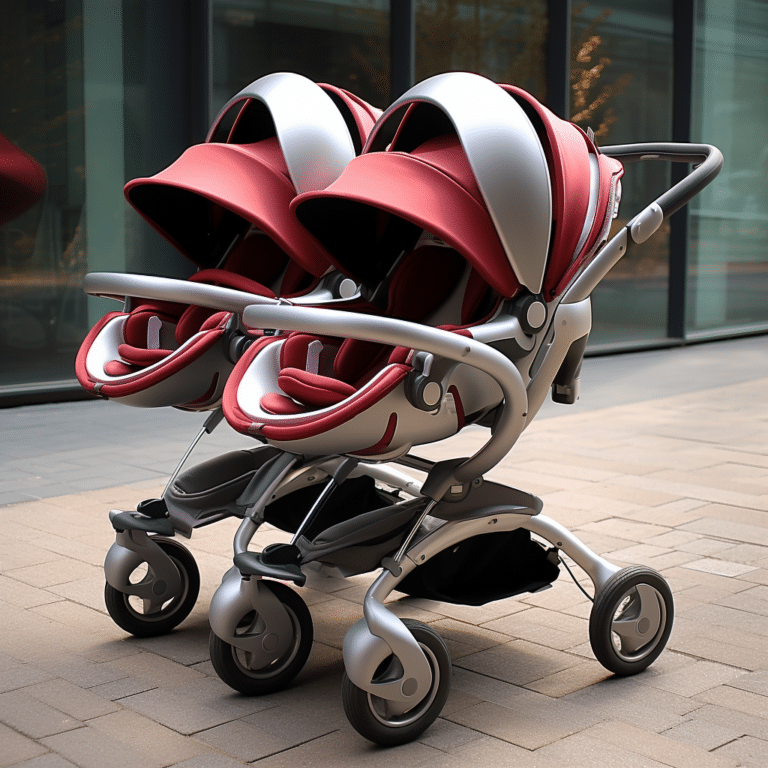Mastering Swaddling: The Gentle Art for Newborns
Welcome to my swaddling tutorial, where I will guide you through the gentle art of swaddling your precious newborn. Swaddling is a technique that involves securely wrapping your baby in a lightweight blanket, providing them with a sense of comfort and security. Not only does swaddling soothe newborns, but it also prevents the startle reflex, promotes longer sleep durations, enhances breastfeeding, and reduces crying and colic symptoms. Let’s dive into the world of swaddling and discover how it can bring comfort to your little one.
Key Takeaways:
- Swaddling is a technique that involves securely wrapping a baby in a lightweight blanket.
- It provides newborns with a sense of security and comfort.
- Swaddling can soothe newborns, prevent the startle reflex, promote longer sleep durations, enhance breastfeeding, and reduce crying and colic symptoms.
- Choosing the right material and size for swaddling blankets is essential for your baby’s comfort.
- Safe and effective swaddling techniques should be followed to ensure the well-being of your baby.

Understanding the Benefits of Swaddling
Swaddling provides babies with a sense of security and comfort, mimicking the snug feeling of being in the womb. The gentle art of swaddling offers several benefits for both babies and parents.
One of the key benefits of swaddling is its ability to reduce the startle reflex. This reflex, also known as the Moro reflex, can cause newborns to suddenly jerk their limbs and wake themselves up. By swaddling, the movement of the limbs is restricted, resulting in longer and more peaceful sleep durations for the baby.
In addition to promoting better sleep, swaddling can enhance breastfeeding. When babies are swaddled, they are typically calmer and more focused, making it easier for them to latch onto the breast and feed comfortably. This can be particularly helpful for new moms who are navigating the early days of breastfeeding.
Furthermore, swaddling has been shown to reduce crying and colic symptoms in some babies. The sense of security provided by swaddling can help soothe fussy infants and provide them with a comforting environment. It’s important to note that every baby is unique, and while swaddling may work wonders for some, it may not have the same effect on others.
Benefits of Swaddling:
- Provides a sense of security and comfort
- Reduces the startle reflex, promoting longer sleep durations
- Enhances breastfeeding by creating a calm and focused environment
- Can help reduce crying and colic symptoms in some babies
In summary, swaddling is a valuable technique that offers a range of benefits for both babies and parents. It provides a sense of security, reduces the startle reflex, promotes longer sleep durations, enhances breastfeeding, and may help reduce crying and colic symptoms. However, it’s essential to remember that swaddling should be done safely and in accordance with the baby’s individual needs and preferences.
| Benefits of Swaddling |
|---|
| Provides a sense of security and comfort |
| Reduces the startle reflex, promoting longer sleep durations |
| Enhances breastfeeding by creating a calm and focused environment |
| Can help reduce crying and colic symptoms in some babies |
Choosing the Material and Size for Swaddling Blankets
When it comes to selecting the perfect swaddling blankets for your baby, there are a few factors to consider. The material of the blanket plays a crucial role in providing comfort and breathability. Some popular options include muslin, bamboo, cotton, and flannel.
Muslin blankets are known for their softness and breathability, allowing air circulation to keep your baby cool and comfortable. Bamboo fabric is hypoallergenic and temperature-regulating, ensuring a cozy swaddle that is gentle on sensitive skin. Cotton is another excellent choice, known for its soft and breathable nature. If you’re looking for extra warmth and coziness, flannel blankets provide the perfect snuggle factor for colder climates.
In addition to choosing the right material, considering the size of the swaddle blanket is important. A general guideline is to select a blanket that is large enough to securely wrap around your baby while still allowing freedom of movement for their hips and legs. This ensures that your little one remains comfortable and avoids any restrictions in their natural development.
Table: Comparison of Swaddling Blanket Material
| Material | Description | Benefits |
|---|---|---|
| Muslin | Soft and breathable | Allows air circulation, keeps baby cool |
| Bamboo | Hypoallergenic and temperature-regulating | Safe for sensitive skin, maintains optimal temperature |
| Cotton | Soft and breathable | Gentle on the skin, suitable for all climates |
| Flannel | Warm and cozy | Provides extra warmth in colder weather |
By choosing the right material and size for your swaddling blankets, you can ensure that your baby is snug, comfortable, and ready for a peaceful sleep.
Step-by-Step Guide for Wrapping Your Little One
Swaddling your baby can be a soothing and comforting experience for both you and your little one. Follow this step-by-step guide to learn how to swaddle a baby:
Step 1: Prepare the Blanket
Start with a large, thin, and breathable blanket or a purpose-made swaddling blanket. Lay the blanket in a diamond shape on a flat surface.
Step 2: Fold the Top Corner
Take the top corner of the blanket and fold it down towards the center to create a straight edge.
Step 3: Place the Baby
Place your baby on their back with their shoulders aligned with the fold of the blanket. The baby’s neck and head should be above the folded edge.
Step 4: Wrap Left Corner
Take the left corner of the blanket and pull it across the baby’s body, securely tucking it under their back. Ensure that the baby’s arms are positioned comfortably at their sides.
Step 5: Lift and Fold Bottom Corner
Lift the bottom corner of the blanket and fold it up over the baby’s feet, making sure their legs can still move freely. The folded edge should be around chest level.
Step 6: Secure with Right Corner
Bring the right corner of the blanket across the baby’s body and tuck it under their left side, ensuring a secure and comfortable swaddle. The blanket should be snug but not too tight, allowing your baby to breathe comfortably.
Remember, every baby is unique, and some may prefer variations of the traditional swaddle. Experiment with different techniques and adjust the tightness of the swaddle to find what works best for your little one. Always monitor your baby while they are swaddled to ensure their safety and comfort.
| Step | Description |
|---|---|
| 1 | Prepare the blanket by laying it in a diamond shape. |
| 2 | Fold the top corner of the blanket to create a straight edge. |
| 3 | Place the baby on their back with their shoulders aligned with the fold, and their head above the folded edge. |
| 4 | Wrap the left corner of the blanket across the baby’s body and securely tuck it under their back. |
| 5 | Lift the bottom corner of the blanket and fold it up over the baby’s feet. |
| 6 | Bring the right corner of the blanket across the baby’s body and tuck it under their left side. |
Swaddling can provide a sense of security and comfort for your baby, helping them sleep more peacefully. Just remember to always follow safe swaddling practices and adjust the swaddle as needed to ensure your little one’s safety and comfort.
Tips for Safe and Effective Swaddling
When it comes to swaddling your baby, safety is of utmost importance. Here are some essential tips to ensure safe and effective swaddling:
- Allow room for hips and legs: It’s crucial to swaddle your baby in a way that allows their hips and legs to move freely. Make sure the swaddle is snug but not too tight, ensuring your little one has enough space for natural movement.
- Avoid overheating: To prevent your baby from getting too hot while swaddled, choose a lightweight blanket and dress them appropriately for the room temperature. It’s important to monitor their body temperature and adjust their clothing or swaddle as needed.
- Know the signs to stop swaddling: Swaddling should be discontinued once your baby shows signs of rolling over onto their tummy. This usually happens around 2 to 3 months of age, but every baby is different. Keep a close eye on your little one’s developmental milestones and consult with your pediatrician for guidance.
By following these safe swaddling practices, you can help ensure your baby’s comfort and reduce the risk of any potential hazards. Always prioritize your baby’s well-being and consult with your healthcare provider if you have any concerns or questions about swaddling.
| Tips for Safe and Effective Swaddling |
|---|
| Allow room for hips and legs |
| Avoid overheating |
| Know the signs to stop swaddling |
The Benefits of Swaddling a Baby
Swaddling is a time-honored practice that offers numerous benefits for babies. When wrapped snugly in a soft blanket, infants experience a sense of safety and security that mimics the cozy environment of the womb. This feeling of being held can help prevent babies from spiraling out of control, soothing them and promoting a calm and peaceful sleep.
One of the key advantages of swaddling is that it provides a safe alternative to loose blankets in the crib. By securely wrapping the baby, there is a reduced risk of suffocation and entanglement. The gentle pressure of the swaddle can also activate the baby’s calming reflex, reminding them of the familiar sensations of the womb and promoting relaxation.
Swaddling not only benefits the baby but also offers reassurance to parents. With the baby snugly swaddled, parents can have peace of mind knowing that their little one is safe and comfortable. It can also help establish a bedtime routine and promote better sleep for both the baby and the parents.
“Swaddling provides infants with a sense of safety, security, and familiarity, mimicking the snug hug of the womb.”
In summary, swaddling offers a range of benefits for both babies and parents. It provides a sense of safety and security, prevents babies from spiraling out of control, offers a safe alternative to loose blankets, and activates a calming reflex. By employing proper swaddling techniques and paying attention to the baby’s comfort, parents can create a peaceful environment that promotes restful sleep and a happy, contented baby.
Which Swaddle Method is Best for Your Baby?
When it comes to swaddling your baby, there are various types of swaddles available to choose from. Each method offers its own unique features and benefits, and finding the one that works best for your baby can help ensure their comfort and effectiveness. Here are some popular swaddle blanket options to consider:
1. Traditional Blankets:
Traditional blankets are a versatile option for swaddling your baby. They come in various materials such as muslin, cotton, or flannel, providing softness and breathability. With a little practice, you can master the art of swaddling using a traditional blanket and create a customized fit for your baby.
2. Velcro Swaddles:
Velcro swaddles are designed with convenient fastenings that make swaddling quick and easy. They often feature adjustable flaps or tabs that secure the blanket in place without the need for complicated folding techniques. Velcro swaddles are especially handy for parents who are new to swaddling or prefer a hassle-free option.
3. Swaddle Sacks with Wings:
Swaddle sacks with wings are a popular choice for parents who want a secure and snug fit for their baby. These swaddles typically feature built-in wing flaps that wrap around the baby’s arms, providing an extra layer of security. Swaddle sacks with wings prevent the baby’s arms from escaping the swaddle, reducing the startle reflex and promoting better sleep.
4. Swaddle Sacks with Arms Out:
Swaddle sacks with arms out offer a gentle transition from the traditional swaddle. They allow the baby to have their arms out of the swaddle while still providing a cozy and secure environment. Swaddle sacks with arms out are suitable for babies who are starting to show signs of rolling over or prefer having their arms free for movement.
Remember, the most important factor in swaddling is the fit of the swaddle rather than the type. It should be snug but not too tight to restrict movement or breathing. Pay attention to your baby’s cues and preferences to determine which swaddle method works best for them. With the right swaddle, your baby can experience the comfort and security they need for a peaceful sleep.
When and How to Transition from Swaddling
Swaddling is a wonderful technique to provide comfort and security to newborns, but there comes a time when it’s necessary to transition away from it. Knowing when to stop swaddling and how to do it can ensure a smooth and safe transition for you and your baby.
The ideal time to stop swaddling is when your baby starts showing signs of trying to roll over. Rolling over is an important developmental milestone, and swaddling can restrict their movement and pose a safety risk. Generally, this occurs around 2 to 4 months of age, but every baby is different, so it’s essential to observe your little one for signs of readiness.
Transitioning from swaddling can be done gradually to help your baby adjust. One effective method is to start by swaddling with one arm out while keeping the other arm inside the swaddle. This allows your baby to explore and become accustomed to the freedom of movement. After a few days, you can gradually transition to both arms out of the swaddle. At this stage, you can introduce a sleep sack, which provides a similar sense of security but allows more mobility.
A sleep sack is a wearable blanket that keeps your baby cozy and secure while they sleep. It eliminates the need for a traditional swaddle and reduces the risk of loose blankets in the crib. Sleep sacks come in various sizes and designs, catering to different stages of your baby’s development. Look for a sleep sack that provides a snug fit without being too tight and allows free movement of the legs for healthy hip development.
Transitioning from Swaddling: Step-by-Step Guide
- Start by swaddling with one arm out while keeping the other arm inside the swaddle.
- After a few days, transition to both arms out of the swaddle while still using the swaddle blanket.
- Introduce a sleep sack once your baby is comfortable with both arms out.
- Choose a sleep sack that fits snugly but allows freedom of movement for healthy hip development.
Transitioning from swaddling can take time and patience, as every baby adjusts differently. It’s important to monitor your baby’s cues and comfort level during the transition process. Remember, a sleep sack provides a safe and secure alternative to swaddling, ensuring your baby’s comfort and promoting a restful sleep.
| Time Frame | Transition Steps |
|---|---|
| 0-2 months | Swaddle with both arms in |
| 2-4 months | Swaddle with one arm out |
| 4+ months | Transition to sleep sack with both arms out |
Safe Sleep Practices and Swaddling
When it comes to swaddling your baby, it’s important to prioritize safe sleep practices. This means creating a sleep environment that promotes both comfort and safety. One key aspect of safe sleep practices is avoiding loose blankets in the crib. Instead, opt for a properly fitted swaddle blanket that securely wraps your baby while allowing for natural movement of the hips and legs.
Using a swaddle blanket that is designed to be hip-safe is essential for preventing hip dysplasia. Look for blankets that are specifically designed to keep the hips flexed and open, reducing the risk of this condition. By choosing a hip-safe swaddle, you can provide your baby with the comfort and security they need while also ensuring their long-term hip health.
Safe sleep practices recommend placing your baby on their back for sleep and removing any loose blankets or pillows from the crib. It’s crucial to follow these guidelines to reduce the risk of suffocation or other sleep-related accidents.
Before swaddling your baby, it’s a good idea to create a calm and soothing environment. You can do this by hugging your baby first and offering a firm but gentle touch. This helps them relax before being wrapped in the swaddle. Remember, always monitor your baby while they are swaddled to ensure they are comfortable and safe. If you have any concerns or questions, don’t hesitate to consult with your pediatrician for further guidance and reassurance.
| Safe Sleep Practices and Swaddling | Key Points |
|---|---|
| Avoid loose blankets | Use a properly fitted swaddle blanket instead |
| Choose a hip-safe swaddle | Ensure your baby’s hips are flexed and open |
| Place your baby on their back for sleep | Reduce the risk of suffocation by following safe sleep guidelines |
| Create a calm environment before swaddling | Hug your baby first and offer a gentle touch to soothe them |
| Monitor your baby while swaddled | Ensure their comfort and safety at all times |
Conclusion
In conclusion, the gentle art of swaddling provides newborns with comfort and security. By securely wrapping them in a lightweight blanket, parents can mimic the snug feeling of being in the womb, helping their little ones feel safe and protected.
Swaddling offers numerous benefits, including soothing babies, preventing the startle reflex, promoting longer sleep duration, enhancing breastfeeding, and reducing crying and colic symptoms. It creates a calm and focused environment for both baby and parent, allowing for better bonding and a sense of routine.
When swaddling, it’s important to choose the right material and size for the swaddle blanket. Lightweight and breathable fabrics such as muslin, bamboo, cotton, or flannel are ideal choices. The blanket should be large enough to securely wrap the baby while still allowing for proper movement of the hips and legs.
Remember to follow safe swaddling practices, such as avoiding overheating and ensuring the baby’s comfort and safety. Swaddling should be discontinued once the baby shows signs of rolling over or around 2 months of age. At that point, transitioning to a sleep sack can provide a similar sense of security while allowing for more movement.
FAQ
What is swaddling?
Swaddling is a technique that involves securely wrapping a baby in a lightweight blanket to provide them with a sense of security and comfort.
What are the benefits of swaddling?
Swaddling can help soothe newborns, prevent the startle reflex, promote longer sleep duration, enhance breastfeeding, and reduce crying and colic symptoms.
What materials are best for swaddling blankets?
Opt for lightweight and breathable fabrics such as muslin, bamboo, cotton, or flannel.
How do I swaddle a baby?
Lay the blanket in a diamond shape, fold the top corner, place the baby on their back, wrap the left and right corners, and secure the blanket.
How tight should I swaddle the baby?
Swaddle securely but not too tight to allow room for the baby’s hips and legs to move freely.
When should I stop swaddling?
Swaddling should be discontinued once the baby shows signs of rolling over onto their tummy or around 2 months of age.
What are the safe sleep practices when swaddling?
Place the baby on their back for sleep, avoid loose blankets and pillows in the crib, and ensure the swaddle allows the baby’s hips to be flexed and open to avoid hip dysplasia.
Are there different types of swaddles?
Yes, there are various types of swaddles available, including traditional blankets, velcro swaddles, swaddle sacks with wings, and swaddle sacks with arms out.
How do I transition from swaddling?
Transition from swaddling by using a sleep sack as a safe alternative. Start by swaddling with one arm out and gradually remove the second arm from the swaddle.
Is swaddling safe for my baby?
When done correctly and following safe sleep practices, swaddling is safe and can provide infants with comfort and security.







